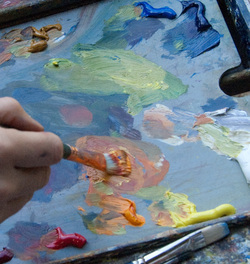Tools & Techniques Workshop Series: No Workshops scheduled

If you want to participate in this workshop, click here to send me an e-mail as we're building a list of interested artists. When we have enough people interested, we'll schedule a new workshop series.
Do you have difficulty mixing the right colour?
Do you wonder why some paintings seem to work, while others don’t?
Why do some paintings created in wildly unrealistic colours work so well, when other more realistically coloured paintings don’t stir you?
In these six workshops, you will explore colour, composition, value and perspective.
1. Colour theory revised, made clear and made practical. In this session, we will explore an adjusted, artist-oriented version of the colour wheel. We will paint a still life, putting the new theory into practice.
2. Mixing colours. Just what is that colour I'm looking at - and how do I mix it? We build upon the basic understanding from session 1, mixing more complex and subtle colours. We will again work from a still life practicing subtle colour mixing.
3. Composition. It's more than reproducing a nice scene. Where are the lines that make up the backbone of your composition? How do you determine what shapes to establish? In this class, we go over basic compositional theories (western and oriental) using them to dismantle the composition of a number of well-know artists to see what they saw. With these insights, you will review your own photo references to discover the composition(s) in each. Then capture your chosen composition in a simple line sketch.
4. Values! They determine your shapes. and shapes are built upon your perceived lines. Using a series of examples, we will explore values and discover how understanding and seeing the values, and the big shapes that they are formed by, helps in your painting, no matter what style you are pursuing.
5. Perspective. More than big and small, measurement and angles, although it’s all that too. In landscape and architecture, perspective imparts vital information. It's equally important in portraiture, if a little more subtle. We will discuss, show examples and demonstrate linear perspective. However, we will also look into atmospheric perspective and the role colour plays to create distance.
6. Putting it all together. Critique. Where did you go right, what might you work on to improve? In this session, you will create a painting from composition to atmospheric perspective. After we are all done, time will be spent analyzing the technical aspects of your work. Colour mixing, composition, values & shapes and perspective.
Six 3-hour evening classes over six weeks TBA.
Classes run from 6pm until 9 pm.
Classes held in Markham, Ontario
$195 + hst = $220.35
Minimum class size 5, maximum class size 10.
Sign up using our secure Paypal interface
Or send a cheque to: 15 Wilson Street, Markham, Ontario, L3P 1M9
Contact us at 905-472-2330 or [email protected] if you have any questions, or wish to book a space.
Materials List (If you paint in oil, please call first. Mixing colours is the same in both media.)
Acrylic Paint
Hansa Yellow Light
Hansa Yellow medium (Indian Yellow)
Quinacriidone Magenta
Napthol Red Light (or Cadmium Red Light)
Phthalo Blue Green Shade (Phthalocyanine)
Indanthrene Blue (Anthraquinone Blue or Ultramarine Blue)
Phthalo Green Yellow Shade
Burnt Umber
Titanium White
Brushes
Synthetic Brights, 1", 1/2", Filbert #4 (Brights are similar to Flats, simply shorter, stiffer bristles)
1 palette knife (Important. Needed for colour mixing.)
Painting Surfaces
6 canvases or boards, 11x14 or 12x16
1 8x10 book of watercolour paper for colour mixing experiments
1 small sketch book (As small as 3.5 x 5)
Other Stuff
Pencils 2B, 5B, 7B (or one pencil & 3 Tombow markers N95, N65 & N15)
Chalk
White eraser
Yogurt Tub for cleaning brushes
Rags for cleaning brushes
Palette (We use non-stick baking sheets) Do not bring tiny paper plates or other mini palettes. A palette should be at least 11x14.
Table-top easel
Plastic sheet to cover table
Note book & pen
Contact us at 905-472-2330 or [email protected] if you have any questions, or wish to book a space.
Materials List (If you paint in oil, please call first. Mixing colours is the same in both media.)
Acrylic Paint
Hansa Yellow Light
Hansa Yellow medium (Indian Yellow)
Quinacriidone Magenta
Napthol Red Light (or Cadmium Red Light)
Phthalo Blue Green Shade (Phthalocyanine)
Indanthrene Blue (Anthraquinone Blue or Ultramarine Blue)
Phthalo Green Yellow Shade
Burnt Umber
Titanium White
Brushes
Synthetic Brights, 1", 1/2", Filbert #4 (Brights are similar to Flats, simply shorter, stiffer bristles)
1 palette knife (Important. Needed for colour mixing.)
Painting Surfaces
6 canvases or boards, 11x14 or 12x16
1 8x10 book of watercolour paper for colour mixing experiments
1 small sketch book (As small as 3.5 x 5)
Other Stuff
Pencils 2B, 5B, 7B (or one pencil & 3 Tombow markers N95, N65 & N15)
Chalk
White eraser
Yogurt Tub for cleaning brushes
Rags for cleaning brushes
Palette (We use non-stick baking sheets) Do not bring tiny paper plates or other mini palettes. A palette should be at least 11x14.
Table-top easel
Plastic sheet to cover table
Note book & pen
